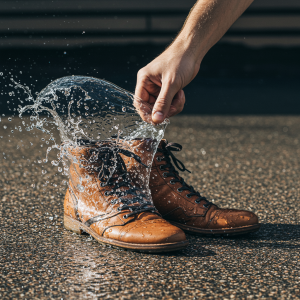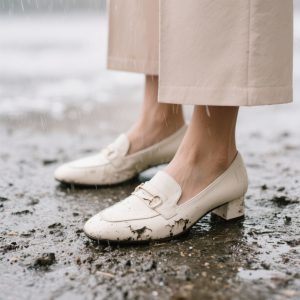
How to Protect Your Shoes from Water, Mud & Snow
Knowing how to protect your shoes from water is crucial for keeping them in optimal condition.
Shoes are more than just accessories — they’re our daily support system. We rely on them for school, work, workouts, errands, and nights out. They carry us through puddles, slushy pavements, muddy fields, dry sidewalks, and everything in between. Yet, they’re often the most overlooked part of our outfits. We don’t think much about them until they start to wear out: soles peeling off, leather cracking, strange smells, or ugly salt stains from winter streets.
But it doesn’t have to be that way. With just a bit of knowledge and regular care, you can learn how to protect your shoes from water, mud, snow, and daily wear. Not only will your shoes last longer, but they will also look better and stay comfortable.
By understanding how to protect your shoes from water, you can prevent issues before they start.
Learning how to protect your shoes from water is essential for maintaining their quality and longevity.
Mastering how to protect your shoes from water will not only extend their lifespan but also maintain their aesthetic appeal.
In this guide, we’ll go over the most common ways shoes get damaged, how weather affects different materials, the best cleaning methods for various types of shoes, quick fixes you can handle at home, and when it’s time to let the professionals take over. Whether you wear leather boots, sporty trainers, suede sneakers, or high heels, you’ll find helpful tips here.
Let’s dive deeper into methods for effectively protecting your shoes from water.
From weather changes to daily wear, understanding how to protect your shoes from water can save you money and time in the long run.
Incorporating strategies on how to protect your shoes from water can save you money in the long term.
Everyday Problems That Damage Shoes (And How to Protect Your Shoes from Water)
 Knowing how to protect your shoes from water prevents both cosmetic and structural damage.
Knowing how to protect your shoes from water prevents both cosmetic and structural damage.
It is essential to understand how to protect your shoes from water to avoid costly repairs.
Shoes go through a lot more than we realise. They’re constantly exposed to rough conditions. Let’s explore what really causes shoe damage and how to stay ahead of it:
Understanding how to protect your shoes from water helps maintain their integrity.
Worn-Out Soles
Every time you walk, your soles take a hit. Over time, they wear down unevenly, especially if you have a favourite pair you wear often. Worn-out soles can alter your gait, compromise your posture, and even contribute to knee or back pain.
Regularly learning how to protect your shoes from water can prove invaluable.
Tip: Rotate your shoes every other day. Giving them a break helps them last longer and keeps your feet supported.
Loose Heels or Toes
Moisture, bad glue, or heavy use can cause shoes to separate at the heel or toe. This is especially common with formal shoes, boots, or shoes made with weak adhesive.
Tip: Use waterproof sprays regularly. Keeping water out helps glue last longer and reduces damage from expansion and contraction.
Water Damage
Water can quickly ruin leather and fabric shoes. Leather dries out and cracks. The fabric stretches, changes shape, or starts to smell unpleasant. Even the glue holding your shoes together can fall apart after getting soaked.
Being proactive about protecting your shoes from water can save you from future headaches.
Pro Tip: Apply waterproofing treatments at least once a month, and always before wearing new shoes in bad weather. Keep a small towel in your bag or locker to wipe down wet shoes as soon as possible.
Mastering the art of protecting your shoes from water can significantly enhance their lifespan.
Remembering how to protect your shoes from water will enhance their longevity.
Salt and Snow Stains
In winter, roads and sidewalks are often covered with salt to melt ice. Salt can stick to your shoes, especially when they’re wet, leaving unsightly white stains. Worse, salt can dry out leather, leading to cracks and splits.
Fix: Mix equal parts white vinegar and water. Use a soft cloth or sponge to wipe away the salt. Then, apply a leather conditioner to rehydrate the material.
Dirt, Mud, and Dust
It’s essential to know how to protect your shoes from water when engaging in outdoor activities.
Outdoor shoes pick up a ton of debris. Mud, dust, and grime can seep into the seams, weakening the stitching and causing your shoes to look older more quickly. The more these particles build up, the harder they are to clean later.
Fix: After wearing shoes outside, especially in bad weather, take a few minutes to brush off mud and dirt. Let the mud dry before brushing so it doesn’t smear.
Sunlight and Heat
Not many people consider this, but direct heat — such as leaving your shoes next to a heater or in sunlight — can cause the materials to warp and dry out. Leather can crack, glue can melt, and colours can fade.
Tip: Always dry your shoes naturally. Stuff them with newspaper or use cedar shoe trees to absorb moisture and keep their shape.
Effective methods for protecting your shoes from water will keep them looking new.
Using the proper techniques to protect your shoes from water is vital.
By staying aware of these issues, you’ll be better prepared to protect your shoes from water and other elements.
One of the best ways to protect your shoes from water is through regular maintenance.
How Weather and Ground Conditions Mess with Your Shoes
 Weather plays a significant role in how long your shoes last. Different types of weather bring their own challenges. Here’s how to prepare for each:
Weather plays a significant role in how long your shoes last. Different types of weather bring their own challenges. Here’s how to prepare for each:
Climate awareness is part of knowing how to effectively protect your shoes from water.
Weather conditions can severely impact your boots, so knowing how to protect your shoes from water is crucial.
Understanding the nuances of protecting your shoes from water under different weather conditions is key.
Rain
Leather shoes soaked in rain can shrink, stretch, or crack when they dry. This happens because water alters the leather’s structure, breaking down its natural oils and flexibility. As the leather dries, it becomes stiff and brittle, leading to permanent creases or cracks. Fabric shoes, especially those made from cotton or mesh, tend to absorb and retain more water, which can make them heavy, soggy, and misshapen. Long drying times also encourage bacteria and mould to grow inside, especially in the insoles, causing unpleasant odours and even potential skin irritation.
What to Do:
- Spray your shoes with waterproofing spray every couple of weeks. Look for products that are specifically designed for your shoe material — leather sprays are different from those for suede or canvas.
- If your shoes do get wet, remove the insoles and laces (if possible) and wipe them with a dry towel to remove as much moisture as possible.
- Never use a hairdryer or place your shoes next to a radiator. Direct heat will warp them. Instead, stuff them with paper towels or newspaper to absorb moisture naturally and let them air dry in a well-ventilated space.
- To help your shoes keep their shape, insert a shoe tree or roll a small towel into the toe box.
Snow and Salt
Snow is just frozen water, but when it melts on your shoes, it soaks the material. Salt, used to de-ice roads and pavements, can be absorbed by wet shoes and cause chemical damage to leather and suede. It draws out moisture from the material, leaving behind white, chalky stains and accelerating cracking and dryness.
What to Do:
Understanding how to protect your shoes from water can help prevent long-term damage.
This knowledge on how to protect your shoes from water will serve you well.
- As soon as you get home, brush off loose salt or snow before it melts.
- Mix equal parts white vinegar and water, then gently dab the mixture onto the salt stains using a cloth. This helps break down the salt and remove the white marks.
- Let your shoes dry naturally, then apply a leather conditioner to replenish the moisture lost during cleaning.
- Consider wearing waterproof rubber shoe covers or overshoes in heavy snow to fully protect your footwear.
Mud
Mud is more than just a dirty mess — it’s a mix of water and abrasive soil that can grind into seams, fabric, and stitching. When mud dries, it hardens and can stiffen or fray the fibres in your shoes. If left on too long, it can also stain the material.
What to Do:
- Allow the mud to dry thoroughly before attempting to clean it. Trying to wipe wet mud usually makes the mess worse.
- Once dry, gently remove the mud with a soft-bristled brush. Avoid scrubbing too hard, especially on delicate fabrics like suede.
- If needed, clean with a mix of warm water and a small amount of mild soap, then blot dry with a towel.
- Spray the shoes with a fabric protector once they are scorched to prevent future stains.
Hot Pavement or Dry Weather
Heat can cause your shoes to dry out — literally. Leather shoes are especially vulnerable, as high temperatures can cause the natural oils that keep them flexible to evaporate. This results in cracking, stiffness, and shrinkage. The glue used in many shoes can also soften or melt in extreme heat, causing the soles or linings to separate from the rest of the shoe.
What to Do:
- Store your shoes in a cool, dark place away from windows, radiators, or heaters.
- Apply a leather conditioner regularly during hot months to keep the material hydrated.
- Don’t leave your shoes in a hot car or on a sunny windowsill, as the heat buildup can be extreme and damaging.
Learning how to protect your shoes from water also means understanding how different weather conditions — rain, snow, mud, or heat — affect your footwear. Once you know what to watch for, you can take steps to keep your shoes looking sharp and feeling comfortable all year long.
To truly master protecting your shoes from water, keep these tips in mind.
By following these tips, you will be well-equipped to protect your shoes from water.
By practising protecting your shoes from water, you ensure they remain stylish and functional.
Simple Shoe Fixes You Can Do Yourself
Implementing strategies on how to protect your shoes from water will enhance their durability.
You don’t always need a cobbler to make your shoes wearable again. There are many quick fixes you can do at home that will not only save money but also extend the life of your shoes. These at-home solutions are beneficial when you’re in a hurry or dealing with minor issues that don’t require professional tools or skills.
Knowing how to protect your shoes from water can make a significant difference in their appearance.
Loose Soles
When the sole of your shoe starts to separate from the upper part, the issue can quickly worsen. Walking on a partially detached sole can damage the shoe further and cause an uneven step, which might affect your posture or balance.
Fix: Use a strong adhesive, such as Shoe Goo or Gorilla Glue. Clean the area thoroughly before applying the glue to remove dirt and oils that might prevent it from sticking. Apply a thin, even layer of glue to both surfaces. Press the sole and upper together firmly, then clamp the shoe or place a heavy object on top to maintain pressure overnight. Let it cure fully before wearing.
Addressing minor issues promptly is crucial for protecting your shoes from water damage.
Small Rips
Small tears in the fabric, mesh, or canvas of your shoes can quickly grow if left untreated. They often appear near seams or areas that flex the most, like the toe box.
Fix: For fabric shoes, you can sew the rip shut using a curved needle and durable thread. Use small, tight stitches and tie off securely. For added protection, consider adding a fabric patch or applying a small amount of fabric glue over the stitch. For leather shoes, use a leather filler or repair paste to fill the crack. Once dry, sand it smooth and apply polish to match the colour.
Scuffed Leather
Leather scuffs when it rubs against rough surfaces, and over time, minor scuffs accumulate, making shoes appear old.
Fix: Start by wiping the scuffed area with a damp cloth to remove dust. Then apply a matching shoe cream or polish with a soft cloth in a circular motion. Buff gently with a brush or clean rag. For deeper scuffs, use a leather conditioner or cream first to soften the area, followed by a tinted polish to blend the damage.
Broken Laces or Eyelets
Laces can snap from wear or fraying, and metal eyelets can fall out or bend. This not only affects appearance but also weakens the shoe’s fit and function.
Fix: Replace the laces with new ones, ensuring the length and type (round, flat, or waxed) match your shoe. If an eyelet falls out or breaks, you can buy a repair kit that includes new eyelets and a setting tool. These kits are simple to use and require just a little hammering to secure the replacement eyelet.
Heel Tips and Pads
When the rubber tips on your heels wear down, your shoes can become loud or slippery, causing discomfort. You may also start to notice uneven walking or increased pressure on your feet.
Fix: Heel tip replacement kits are available for purchase online or at shoe repair shops. To install, pull out the old tip (use pliers if necessary), align the new one with the hole, and gently tap it into place with a hammer until it’s secure. Always choose the right size and shape to match the heel.
Having a small shoe repair kit at home — with glue, polish, a brush, thread, a needle, extra laces, and maybe even a heel tip tool — means you’ll be ready when minor problems pop up. With just a little effort, you can give your shoes a second life and save yourself the cost of replacements.
Using the right products is part of protecting your shoes from water effectively.
Taking the time to learn how to protect your shoes from water is an investment in your wardrobe.
How to Clean Different Types of Shoes
Cleaning your shoes is another way to protect them from water.
Cleaning shoes correctly is just as important as waterproofing them. Different materials need different approaches.
This understanding of how to protect your shoes from water ensures you maintain their quality.
Leather Shoes
Leather is durable but requires care to maintain its good condition. It’s naturally porous, which means it can absorb moisture and dirt. Without regular cleaning and conditioning, leather shoes can dry out, crack, and lose their shape.
- Wipe with a damp cloth to remove dust: This removes surface grime and prevents buildup. Use a soft, dampened cloth (not soaked) and gently wipe across the entire shoe.
- Use leather cleaner or saddle soap: These products clean deeper than water alone. Apply with a soft cloth or sponge, gently scrubbing areas with stains or built-up grime. Always follow the instructions on the product label.
- Apply leather conditioner to keep them soft: Conditioning replenishes the natural oils lost through wear and cleaning. Without this step, leather becomes brittle over time.
- Polish to restore colour and shine: Use a wax or cream polish that matches your shoe’s colour. This hides scuffs and renews the finish. Let the polish sit for a few minutes before buffing.
- Buff with a soft brush or towel: This helps smooth the polish and bring out its shine. A horsehair brush works best.
Extra Tip: Store your leather shoes with cedar shoe trees to absorb moisture, maintain their shape, and keep them smelling fresh. Don’t store them in plastic — they need to breathe.
To prevent damage, always remember how to protect your shoes from water effectively.
Suede Shoes
Suede is softer than leather and easily damaged by moisture. It requires different tools and techniques.
- Brush gently with a suede brush: Brushing lifts dirt and keeps the nap (texture) looking even. Brush in one direction for light cleaning; use back-and-forth strokes for tougher spots.
- For stains, use a suede eraser: These erasers crumble slightly as they lift marks and embedded dirt. Rub lightly and finish with brushing.
- Never use water — it causes stains and discolouration. Water can permanently damage suede, leaving rings or rough patches.
- Protect your suede with a regular application of suede spray: A suede protector helps repel water and dirt. Spray in a well-ventilated area and let it dry for several hours.
Bonus: Briefly steam your suede before brushing to help loosen grime. Hold the shoe above a steaming kettle for a few seconds, then brush while it’s still warm.
Canvas and Fabric Shoes
These are more casual and breathable but can absorb stains easily. They’re pretty low-maintenance but still benefit from careful cleaning.
-
- Remove laces and insoles: These trap sweat and dirt and should be washed separately.
- Mix warm water and mild detergent: Use just enough soap to make suds. Harsh chemicals can weaken the fabric.
- Use a soft brush or sponge to clean the surface. Gently scrub the outside, paying particular attention to the seams and soles, where dirt tends to accumulate.
Finally, regular maintenance is key to protecting your shoes from water.
- Air-dry with paper inside to maintain shape: Never use a dryer or heater—stuff the shoe with paper towels or newspaper to keep its shape while drying slowly.
Odour Tip: Sprinkle baking soda inside and let it sit overnight.
Running Shoes and Trainers
Running shoes and athletic trainers are built with specific materials designed to provide cushioning, support, and breathability. These include mesh fabric, rubber outsoles, foam midsoles, and fabric linings — all of which require gentle, specific care. Unlike casual shoes, running shoes undergo repeated impact and exposure to sweat, which means they require regular maintenance to stay hygienic and functional.
- Remove insoles and hand-wash them separately: Insoles absorb the most sweat and can develop strong odours. Remove them carefully, then soak in a mixture of warm water and mild detergent for 10–15 minutes. Gently scrub them with a brush or sponge, rinse thoroughly, and allow them to air dry completely before reinserting.
- Clean mesh and rubber with soap and water: Use a soft brush or sponge to remove dirt from the mesh uppers and rubber soles. Avoid scrubbing too hard, especially on the mesh, as this can cause it to fray or stretch. Use lukewarm water and a gentle soap — harsh chemicals can damage adhesives and fade colours.
- Stuff with newspaper and air dry: After cleaning, stuff the shoes with newspaper, paper towels, or a dry cloth to help them retain their shape and draw out moisture from the inside. Replace the stuffing once or twice during the drying process to speed it up. Let shoes dry in a cool, well-ventilated area away from direct sunlight or heaters.
Caution: Machine washing may seem convenient, but it can cause severe damage to running shoes. The tumbling motion and high temperatures in a washer can cause the foam midsoles to compress, distort, or separate from the rubber outsole. The glue that holds different layers together can also melt or weaken, shortening the life of your shoes.
Once your shoes are dry, reapply a water-repellent spray designed for synthetic and mesh materials as needed. This will help repel dirt and moisture during your next run, keeping your shoes looking fresher for longer.
7 Ways to Keep Shoes in Top Shape
Good habits go a long way in shoe care. Just like brushing your teeth or washing your face, caring for your shoes regularly prevents long-term damage and keeps them looking great. Here’s a breakdown of simple daily or weekly actions that can significantly extend the life and appearance of your footwear:
- Use a shoehorn to avoid bending the heel: Bending or crushing the heel every time you slip your foot into a shoe weakens its structure. A shoehorn keeps the heel firm, prevents folds or creases, and makes putting on shoes easier, especially with tighter styles like dress shoes or boots. Daily habits play a crucial role in protecting your shoes from water and ensuring their longevity.
- Rotate your shoes so each pair gets a break: Wearing the same pair every day wears them out faster. Shoes need time to air out and recover their shape. Alternating pairs daily helps them last longer and keeps your feet more comfortable.
- Wipe off moisture and dirt daily: After each wear, use a soft cloth or brush to remove any visible dirt, dust, or humidity. This prevents grime from setting into the material, which can lead to discolouration, mould, or deterioration over time.
- Store shoes in a breathable bag or box: Place shoes in a container that protects them from dust while allowing for airflow. Avoid plastic containers or tightly sealed spaces, which can trap moisture and lead to mould. Cloth shoe bags or original boxes with small air holes work best.
- Spray waterproofing regularly: A good waterproof spray acts like an invisible shield against water, salt, and stains. Reapply every few weeks, or more frequently in wet weather, to maintain active protection. Be sure to choose the right spray for your shoe material (leather, suede, fabric, etc.).Incorporating a routine to protect your shoes from water will help prevent them from deteriorating.
- Deodorise weekly with cedar, baking soda, or tea bags: Shoes absorb sweat and odour. To keep them fresh, place cedar shoe inserts, a small sachet of baking soda, or even unused tea bags inside them after use. These absorb moisture and neutralise smells overnight.
- Don’t crush your shoes — use proper storage: Piling shoes or squishing them into tight spaces can warp their shape and damage delicate materials. Use a shoe rack or place crumpled paper inside them to hold their form. High-end pairs benefit from shoe trees, which maintain the shoe’s original structure and prevent creases.
These small, thoughtful actions can significantly extend the life, comfort, and style of your shoes. By incorporating them into your routine, you’ll avoid costly repairs and replacements, and enjoy a cleaner, more polished wardrobe every day.
Professional advice can also help you understand how to protect your shoes from water.
When to Visit a Professional Cobbler
Some shoe problems go beyond quick fixes and at-home care. That’s where professional cobblers come in. These are trained experts who specialise in repairing, restoring, and reviving footwear. Think of them like mechanics or surgeons for your shoes — they have the tools, knowledge, and techniques to fix what the average person can’t.
Don’t hesitate to visit a cobbler if:
- The soles are badly worn or peeling: Worn soles reduce traction and can expose the inner part of your shoe. If you notice the tread has disappeared or the sole is coming off entirely, it’s time to replace it.
- The heel is unstable or broken: Heels that wobble or collapse pose a safety risk and cause discomfort. Cobblers can replace or reinforce heels to make them as good as new.
- Stitching has come undone across multiple areas. While small rips can be sewn at home, widespread damage to the stitching weakens the shoe’s structure. A cobbler can restitch using industrial-strength tools.
- The shoe is expensive or vintage and needs special care: Designer shoes, leather boots, or vintage pairs often need careful handling. DIY methods may do more harm than good. Cobblers know how to treat luxury materials properly.
- You want your shoes deep cleaned, recoloured, or refurbished: Whether your leather has faded or your suede looks dull, a cobbler can professionally clean and restore them to look like they just came out of the box.
Cobblers Can:
- Resole shoes and replace worn heels: They can attach new rubber or leather soles, giving your shoes a second life.
- Fix broken zippers: Especially useful for boots or dress shoes with zip closures.
- Dye or recolour faded leather: Skilled cobblers can recolour shoes to match their original hue or even give them a new look.
- Perform deep cleaning and restoration: Using tools like steamers, brushes, and conditioners, cobblers clean beyond surface dirt — revitalising fabric, softening leather, and even rehydrating dried-out soles.
A visit to the cobbler is often far more affordable than buying a new pair, especially when you’ve already broken in and loved your current ones. Think of it as giving your shoes a well-deserved tune-up.
Knowing how to protect your shoes from water will foster a deeper connection to your footwear.
Final Thoughts: Give Your Shoes the Attention They Deserve
Giving your shoes the attention they deserve means understanding how to protect your shoes from water.
Your shoes are with you every step of the way — through storms, adventures, long days, and memorable nights. They protect your feet and help express your personality. But if you don’t take care of them, they’ll wear out fast.
Now you know how to protect your shoes from water, snow, mud, heat, and daily wear. You’ve learned how to clean them based on their materials, fix minor issues yourself, and know when it’s time to see a pro.
Ultimately, knowing how to protect your shoes from water is essential for maintaining their value and appearance.
Ultimately, protecting your shoes from water will enhance your overall shoe care routine.
Caring for your shoes isn’t just smart — it’s also sustainable. It helps reduce waste and saves you money in the long run.
The next time you’re about to step out, check your shoes. Waterproof them, clean them, fix them, love them.
Because every incredible journey starts with a great pair of shoes, walk tall. Stay dry. And protect your shoes from water.
Always remember how to protect your shoes from water to ensure they serve you well for years to come.




No comment